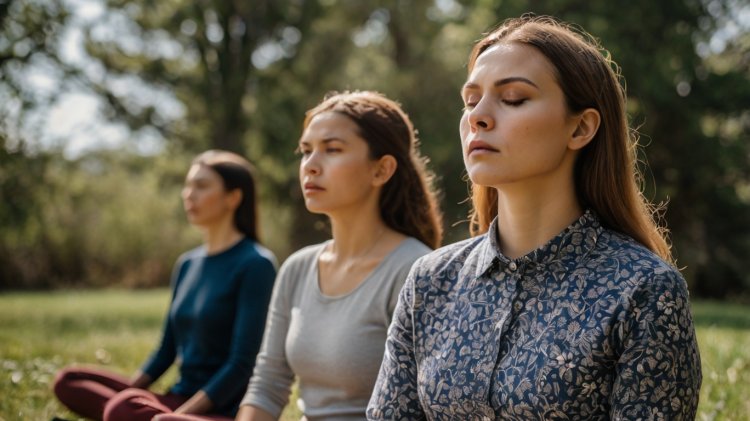8 Breathing Exercises to Relieve Anxiety and Regain Calm
Discover 8 simple and effective breathing exercises to alleviate anxiety and stress. From abdominal breathing to alternate nostril techniques, learn how these practices can help calm your mind, improve focus, and restore balance to your day.

8 Breathing Exercises to Relieve Anxiety and Regain Calm
Stress and anxiety are common challenges in today’s fast-paced world. While occasional stress is natural, persistent anxiety can take a toll on your mental and physical health. Fortunately, simple breathing techniques can provide immediate relief and foster a sense of calm.
This guide explores eight proven breathing exercises to help you manage anxiety effectively.
1. Lengthen Your Exhale
Focusing on a prolonged exhale activates the parasympathetic nervous system, which helps the body relax.
How to Practice:
- Sit or lie in a comfortable position.
- Exhale completely, pushing all the air out of your lungs.
- Slowly inhale through your nose for four seconds.
- Exhale gently through your mouth for six seconds.
- Repeat for 2–5 minutes.
Tip: Let your exhale last longer than your inhale to encourage relaxation.
2. Abdominal (Diaphragmatic) Breathing
Breathing deeply from your diaphragm helps reduce the body’s effort to breathe, fostering a sense of calm.
How to Practice:
- Lie down or sit in a comfortable chair.
- Place one hand on your chest and the other on your stomach.
- Inhale deeply through your nose, allowing your stomach to rise while keeping your chest still.
- Exhale through your mouth, engaging your stomach muscles to push the air out.
- Practice for 5–10 minutes daily to make it a natural response.
Tip: With regular practice, diaphragmatic breathing becomes an automatic relaxation tool.
3. Breath Focus Technique
Combining slow, deep breathing with a calming focus word or image can enhance relaxation.
How to Practice:
- Sit or lie down in a quiet space.
- Breathe slowly and deeply, noticing the rise and fall of your belly.
- Choose a focus word like "peace" or "calm."
- As you exhale, repeat the word mentally or aloud.
- Continue for 10–20 minutes.
Tip: Let go of distracting thoughts and gently bring your focus back to your breath and chosen word.
4. Equal Breathing (Sama Vritti)
This technique balances the inhale and exhale, promoting relaxation and focus.
How to Practice:
- Find a comfortable sitting or lying position.
- Inhale through your nose while counting to four.
- Exhale through your nose for the same four-second count.
- Repeat for 5–10 minutes, gradually extending the count if comfortable.
Tip: Stay mindful of the sensation of fullness and emptiness in your lungs during each cycle.
5. Resonant Breathing (Coherent Breathing)
This method slows your breathing rate to 5 breaths per minute, optimizing the body’s relaxation response.
How to Practice:
- Lie down and close your eyes.
- Inhale through your nose for six seconds, avoiding overly deep breaths.
- Exhale gently for six seconds.
- Continue for 5–10 minutes.
Tip: After the practice, take a moment to notice how relaxed your body feels.
6. Lion’s Breath (Simhasana)
A dynamic breathing exercise, lion’s breath releases pent-up tension and energizes your system.
How to Practice:
- Sit in a kneeling or cross-legged position.
- Inhale deeply through your nose.
- Open your mouth wide, stick out your tongue, and exhale forcefully while making a “ha” sound.
- Repeat 5–6 times.
Tip: This practice can be both a stress reliever and a mood booster.
7. Alternate Nostril Breathing (Nadi Shodhana)
This yogic breathing technique balances the body’s energy and soothes the mind.
How to Practice:
- Sit comfortably and lengthen your spine.
- Close your right nostril with your thumb and inhale through your left nostril.
- Close your left nostril with your ring finger and exhale through your right nostril.
- Inhale through your right nostril, then close it and exhale through your left nostril.
- Repeat this cycle for 5–10 minutes.
Tip: Maintain slow, steady breaths for maximum calming effects.
8. Guided Meditation with Focused Breathing
Guided meditation incorporates breathing exercises with visualization or calming audio prompts.
How to Practice:
- Find a quiet, comfortable space to sit or lie down.
- Listen to a guided meditation recording or app.
- Follow the instructions for breathing and visualization.
Tip: Regular practice can help you rewire your brain to respond calmly to stress triggers.
Benefits of Breathing Exercises
- Immediate Stress Relief: Promotes relaxation and reduces cortisol levels.
- Improved Focus: Helps center the mind during moments of overwhelm.
- Enhanced Sleep: Prepares the body for restful sleep by calming the nervous system.
- Better Emotional Regulation: Encourages mindfulness and reduces reactivity.
FAQs About Breathing Exercises for Anxiety
1. How often should I practice breathing exercises?
Daily practice is ideal, but even a few minutes during stressful moments can make a difference.
2. Can breathing exercises cure anxiety?
While they don’t cure anxiety, they are an effective tool to manage symptoms and complement other treatments.
3. How do I know which breathing exercise is best for me?
Experiment with different techniques to see which feels most natural and calming for you.
4. Can I use these exercises during a panic attack?
Yes, exercises like lengthened exhale and diaphragmatic breathing can help ground you during a panic attack.
5. Are there any risks to practicing breathing exercises?
Breathing exercises are generally safe, but if you feel lightheaded, pause and resume with shorter, gentler breaths.
Conclusion: Breathe Your Way to Calm
Breathing exercises are simple yet powerful tools for reducing anxiety and promoting relaxation. By incorporating these practices into your daily routine, you can equip yourself with effective strategies to handle stress and maintain emotional balance.
Start with just a few minutes each day, and discover how intentional breathing can transform your mental well-being









